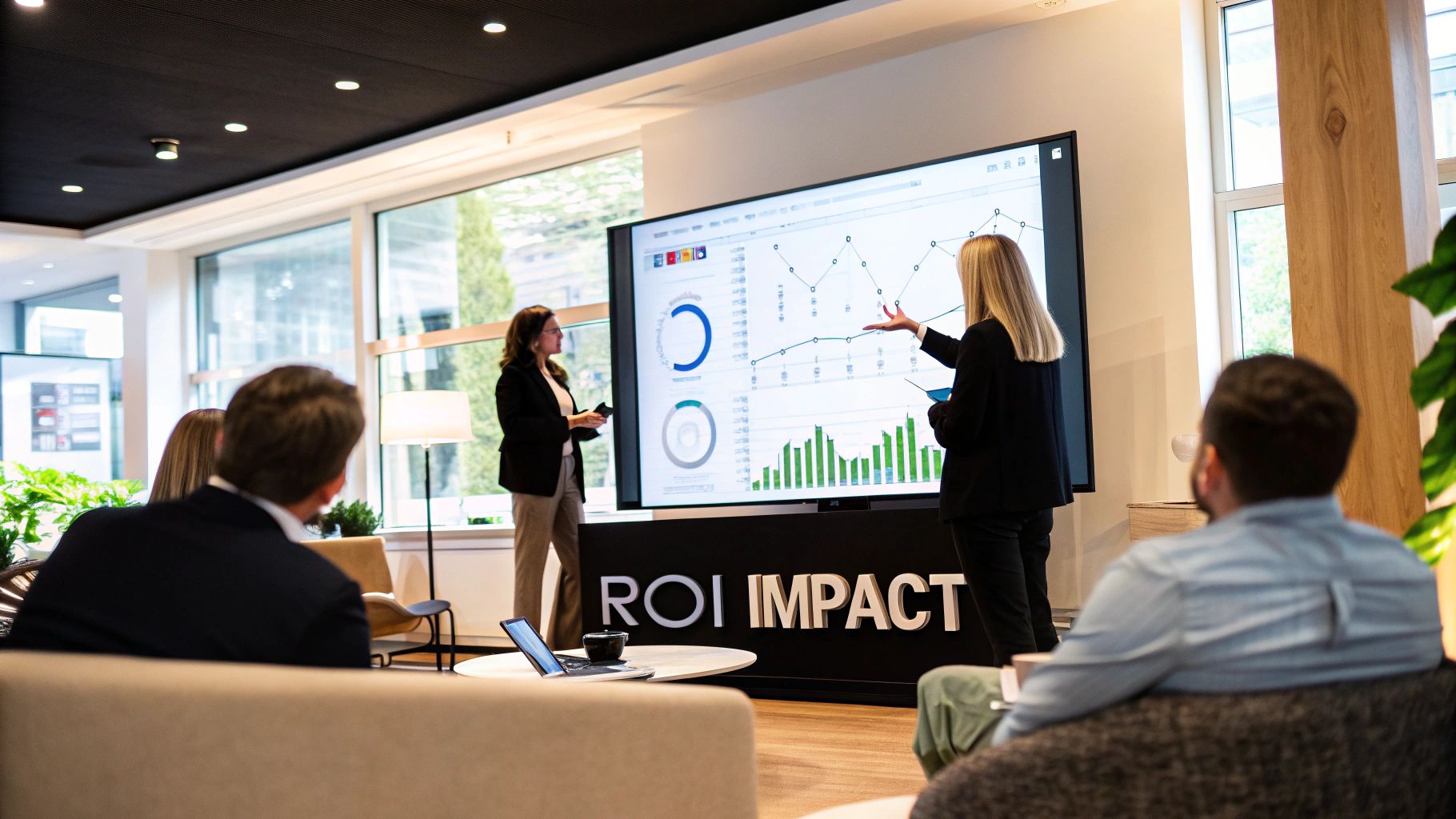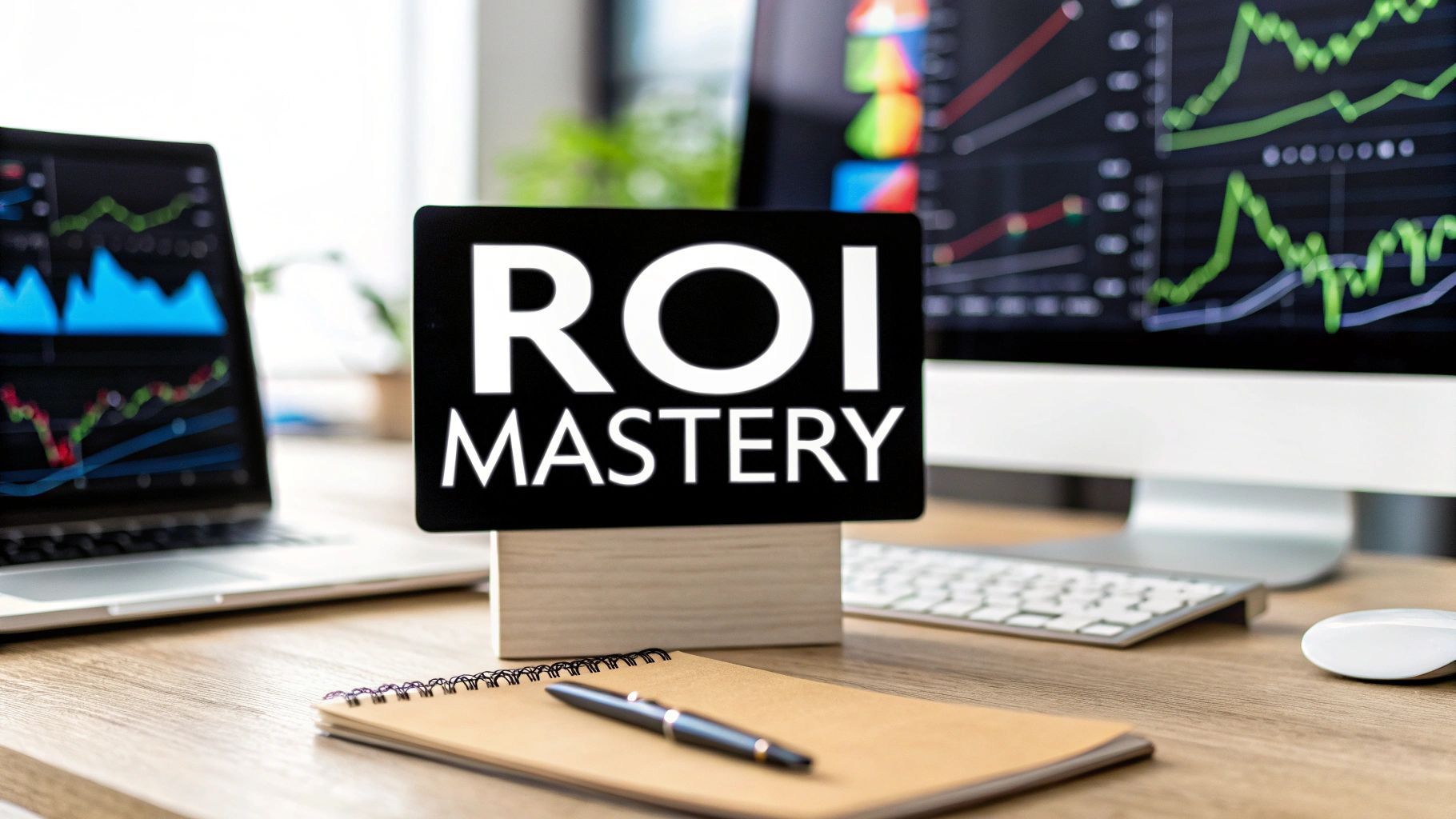Decoding ROI Definition in Modern Marketing

In the ever-evolving world of marketing, proving the value of your work is essential. This is where Return on Investment (ROI) comes into play. Understanding ROI in a marketing context is vital for any UK business seeking growth.
Think of it like hosting an event. You invest in food, decor, and entertainment. The ROI isn't simply the number of attendees, but the valuable connections made and potential future deals. This same principle applies to marketing.
Defining ROI in the UK Marketing Landscape
What exactly is marketing ROI? It measures the profit generated for every pound spent on marketing activities. Often expressed as a percentage, this metric helps you assess campaign effectiveness and justify your marketing budget. Marketing ROI is a critical measure used by UK businesses to assess the effectiveness and profitability of their marketing campaigns. It is defined as the ratio of net profit gained to the cost of those marketing efforts.
For example, if a UK company spends £10,000 on a campaign and generates £20,000 in revenue, its marketing ROI is 100%. This indicates the campaign doubled the initial investment. This metric helps UK marketers pinpoint which strategies deliver the most revenue relative to cost.
A negative marketing ROI occurs when campaign revenue doesn't cover costs, signalling a loss. In the competitive UK market, accurately calculating marketing ROI is more critical than ever for justifying budgets and proving value. The metric encompasses all marketing channels, like digital ads, email marketing, and social media, allowing businesses to compare returns and focus on top performers. Understanding marketing ROI also supports resource allocation, ensuring maximum impact from limited budgets. Learn more about effective ROI calculations here: https://unifida.co.uk/campaign-metrics/what-is-a-good-marketing-roi/
Why ROI Matters More Than Ever
In the competitive UK market, demonstrating the value of marketing spend is crucial. ROI provides a clear view of which campaigns are generating revenue and which are underperforming. This data-driven insight enables informed decisions about future campaigns, optimizing strategies for maximum impact.
This also means justifying budget requests to stakeholders and securing further investment for successful initiatives.
Moving Beyond Basic Calculations
While the basic ROI formula is a good starting point, understanding your true marketing impact needs a more nuanced approach. This involves considering factors like customer lifetime value (CLV), brand awareness, and customer loyalty.
These metrics might not immediately show up in your bottom line, but they are vital for long-term growth and success in the UK market. By incorporating these factors into your analysis, you gain a more comprehensive understanding of your marketing effectiveness.
The Evolution of ROI Measurement That Matters

Measuring Return on Investment (ROI) in marketing was once a straightforward process. A local newspaper advertisement, for example, allowed businesses to roughly track new customers by simply asking how they heard about the company. The advent of digital marketing, however, significantly changed this landscape. The increased number of channels has made it more difficult to pinpoint which specific activity led to a sale.
For instance, a customer might encounter a social media post, click on a Google ad a week later, and ultimately make a purchase after receiving an email offer. This complex customer journey makes assigning credit to a single touchpoint challenging. Traditional methods, like analyzing the return from a single campaign, became less effective.
Adapting to the Multi-Channel World
This shift required UK marketers to re-evaluate their approach to ROI measurement. The existing methods couldn't handle the intricacies of multi-channel marketing. Forward-thinking brands began developing more sophisticated models. They moved away from single-touch attribution (attributing all credit to the last click) and towards multi-touch attribution. This approach distributes credit across all the touchpoints a customer interacts with before purchasing.
In the UK, marketing ROI has become crucial for businesses striving to meet the growing demand for personalized experiences. According to Salesforce UK, improving marketing ROI and attribution is a top priority for marketers nationwide. UK businesses are increasingly adopting advanced analytics to understand how each marketing channel contributes to revenue. For more detailed statistics, visit the Salesforce UK ROI guide.
The Rise of Data-Driven Decisions
Evolving consumer behaviour also played a vital role in how ROI measurement has changed. As customers interact with brands across various platforms, understanding the complete customer journey is essential. This has presented both challenges and opportunities. While accurately attributing value is more complex, the ability to track data across multiple touchpoints provides valuable insights into campaign effectiveness.
This means UK marketers who understand ROI calculations and attribution models gain a significant advantage. They can demonstrate the direct impact of marketing on business results. This data-driven approach empowers marketers to optimize campaigns, allocate budgets effectively, and showcase the value of their work. This focus on measurement and optimization reflects a broader shift in UK marketing culture towards data-driven decisions and increased accountability, shaping industry standards.
ROI Calculation Methods That Actually Work
Calculating your Return on Investment (ROI) is crucial for any marketing campaign. It's not only about demonstrating value to stakeholders. Understanding what resonates with your audience and what doesn't allows you to refine strategies and make the most of your budget, especially in a competitive market like the UK. Let's explore some practical ROI calculation methods.
The Foundational Formula
The basic ROI formula provides a general overview of campaign performance. It's a good starting point for a quick snapshot. The calculation is simple:
(Net Profit – Marketing Cost) / Marketing Cost = Marketing ROI
For instance, if a £5,000 investment in a Facebook ad campaign yields £7,000 in profit, the ROI is:
(£7,000 – £5,000) / £5,000 = 0.4 or 40%
This means every pound invested generated 40 pence in profit. While useful for a broad overview, this basic formula doesn't capture the complexities of modern marketing. For a deeper understanding, we need more advanced approaches.
Beyond the Basics: Customer Lifetime Value (CLV)
Customer Lifetime Value (CLV) is key to long-term ROI. It predicts the total revenue a customer will generate throughout their relationship with your business. CLV helps you see the long-term impact of your marketing, going beyond a single purchase.
A single purchase might show a small initial ROI. However, if that customer becomes a loyal, repeat buyer, the ROI grows significantly over time. This is particularly relevant in the UK, where fostering lasting customer relationships drives sustainable business growth.
Attribution Models for Multi-Channel Success
Today’s customer journey rarely involves a single touchpoint. Customers might engage with your brand on social media, click a Google ad, and finally convert through an email. Attributing the conversion to just one channel provides an incomplete and inaccurate view.
Multi-touch attribution models offer a more realistic perspective by distributing credit across all touchpoints involved in the customer journey. This allows for more effective budget allocation and optimized campaigns across different platforms, essential for integrated marketing strategies.
Adapting to Different Sales Cycles
Sales cycles vary widely depending on the industry and product. A complex B2B sale in the UK could take months, while a purchase on a platform like TikTok Shop might happen in minutes. Your ROI calculations need to account for these differences. For longer sales cycles, track leading indicators like leads generated or qualified opportunities. For shorter cycles, focus on direct sales and conversion rates.
To further illustrate different ROI calculation methods, let’s look at a comparison table:
To help choose the best method for your needs, review the following comparison:
Comparison of Marketing ROI Calculation Methods
| Calculation Method | Formula | Advantages | Disadvantages | Best For |
|---|---|---|---|---|
| Basic ROI | (Net Profit – Marketing Cost) / Marketing Cost | Simple to calculate; provides a quick overview | Doesn't account for long-term value or multi-channel attribution | Short-term campaigns with clear conversion goals |
| Customer Lifetime Value (CLV) | Average Purchase Value * Average Purchase Frequency * Average Customer Lifespan | Considers long-term customer value | More complex to calculate; requires accurate customer data | Businesses focused on building customer relationships |
| Multi-Touch Attribution | Varies based on model (e.g., linear, time decay, position-based) | Provides a more holistic view of marketing impact | Requires sophisticated tracking and analytics | Businesses using multiple marketing channels |
This table summarizes the core differences between these methods, allowing you to choose the best fit for your specific marketing goals and data availability. While the basic ROI calculation is useful for a quick overview, incorporating CLV and multi-touch attribution gives you a more complete understanding of your marketing performance in the long run.
Setting ROI Benchmarks That Drive Real Growth

Understanding the return on investment (ROI) in marketing is essential. But what exactly is a good ROI? This depends significantly on the specific marketing channels used and the industry in which you operate. Simply aiming for industry averages can be a misleading approach. Instead, concentrate on establishing benchmarks that are specifically relevant to your unique business context within the UK market.
Why Industry Averages Can Be Misleading
Consider two businesses selling tea in the UK. One concentrates on premium, loose-leaf teas sold online, while the other sells affordable tea bags in supermarkets. Their target audiences, marketing approaches, and pricing models are completely different. Comparing their ROI solely on the basis of "tea sales in the UK" would be meaningless.
This example illustrates why understanding your specific business model is critical. Successful marketers adapt their ROI targets accordingly.
Establishing Meaningful ROI Targets
Rather than relying on general industry averages, effective UK marketers create benchmarks based on their own specific circumstances. This includes analyzing factors such as:
- Market Maturity: A new product entering the market might prioritize building brand awareness and gaining market share over immediate profit, thus accepting a lower initial ROI.
- Competition Intensity: Highly competitive markets often necessitate a larger marketing budget to stand out, potentially affecting ROI.
- Typical Purchase Values: Businesses with higher average order values can generally tolerate a lower ROI on individual sales.
Realistic ROI Ranges Across UK Marketing Channels
While general averages can be deceptive, understanding typical ROI ranges for various marketing channels provides a useful starting point. This data, combined with your specific business context, helps set achievable yet ambitious goals.
To provide a more comprehensive view of ROI benchmarks, let's examine average figures across a broader range of industries. The following table shows average ROI percentages for different marketing channels in several key UK sectors.
UK Marketing ROI Benchmarks by Channel and Industry
| Marketing Channel | Retail | Financial Services | B2B Technology | Healthcare | Average |
|---|---|---|---|---|---|
| PPC | 450% | 250% | 300% | 200% | 300% |
| Social Media | 250% | 150% | 200% | 100% | 175% |
| Content Marketing | 350% | 200% | 300% | 150% | 250% |
| Email Campaigns | 4000% | 2750% | 3250% | 2500% | 3125% |
This table offers a general overview. Individual business performance may vary. It’s important to use this data as a starting point for your own analysis, considering your specific industry, target audience, and marketing strategies.
Practical Frameworks for ROI-Driven Growth
Setting meaningful ROI benchmarks isn’t a one-time task. It’s an ongoing process of setting objectives, measuring performance, and adjusting strategies. This cyclical approach drives constant improvement and sustainable growth. Consider the following tips for developing an effective framework:
- Set SMART Goals: Ensure your ROI targets are Specific, Measurable, Achievable, Relevant, and Time-bound.
- Regularly Monitor Performance: Don't wait until a campaign ends to analyze ROI. Track key metrics continuously throughout the process. Tools like Mergoio can be invaluable for tracking and optimizing marketing performance, particularly for e-commerce businesses.
- Adapt Your Strategy: Be flexible and willing to modify your approach based on real-time data. Identify underperforming channels and optimize accordingly.
By concentrating on relevant benchmarks and continuously refining your strategies, you can ensure your marketing investments contribute to genuine, lasting growth within the competitive UK business environment.
Beyond Financial Returns: The Complete ROI Picture
While financial returns are undeniably crucial, they only paint part of the picture when it comes to measuring marketing’s true impact. Forward-thinking UK marketers understand the significance of non-financial returns and incorporate them into a more comprehensive ROI framework. This broader perspective acknowledges marketing's vital contribution to long-term growth and brand building, essential elements for sustained success in the competitive UK market.
Capturing the Full Impact: Beyond the Bottom Line
Traditional ROI definition marketing frequently focuses solely on immediate financial gains. However, activities like building brand awareness and fostering customer loyalty contribute significantly to long-term value, even if their immediate financial impact is difficult to measure directly. Think of it like investing in a new storefront for your business: the upfront cost is significant, but the improved brand image and increased foot traffic will likely lead to higher profits over time.
Leading UK brands recognize that brand equity, the overall value of their brand, isn't solely reflected in short-term sales figures. By incorporating metrics like brand awareness, customer sentiment, and social media engagement, they develop a more complete understanding of marketing's influence on brand health and future revenue potential.
Quantifying Qualitative Outcomes: Measuring the Intangible
One of the primary challenges in assessing non-financial returns is quantifying outcomes that are traditionally qualitative. How do you assign a numerical value to increased customer loyalty or improved brand perception? While these metrics aren't as straightforward to measure as sales figures, practical methods exist for gauging their impact.
For example, tracking customer retention rates provides valuable insights into customer loyalty. An increase in returning customers suggests the effectiveness of marketing strategies in building lasting relationships. Similarly, measuring social media engagement, including metrics like likes, shares, and comments, can indicate the strength of your brand presence and customer sentiment.
Balanced Scorecards and Multidimensional Dashboards
To effectively track both financial and non-financial returns, many UK businesses are using balanced scorecards and multidimensional dashboards. These tools provide a holistic view of marketing performance by incorporating a range of key performance indicators (KPIs). For instance, a dashboard might include metrics like:
- Website traffic: A reflection of brand visibility and reach
- Lead generation: Measuring the effectiveness of top-of-funnel marketing activities
- Customer satisfaction scores: Providing insights into the customer experience
- Market share growth: Demonstrating competitive positioning
By integrating these diverse data points, businesses gain a more nuanced understanding of marketing's overall contribution to business objectives. This integrated approach enables more informed decision-making and more effective resource allocation.
Valuing Upper-Funnel Activities: Recognizing Long-Term Drivers
Traditional ROI calculations often underestimate the value of upper-funnel marketing activities, such as content marketing or social media engagement. While these initiatives might not directly translate into immediate sales, they play a crucial role in building brand awareness and nurturing leads. A well-written blog post, for example, might not generate direct sales, but it can drive significant website traffic and establish the brand as a thought leader, ultimately leading to increased conversions down the line.
By developing frameworks for assigning value to these upper-funnel activities, marketers can effectively demonstrate the long-term ROI of these investments. One approach involves tracking lead nurturing progress through the sales funnel, connecting eventual conversions back to initial touchpoints like a blog post or social media interaction. Mergoio, with its comprehensive dashboard and in-depth analytics, can be a valuable tool for tracking these long-term trends and understanding the complete impact of your marketing investments.
By adopting a more holistic approach to ROI definition marketing, UK businesses can fully realize the potential of their marketing efforts, driving both short-term wins and sustainable long-term growth.
ROI Optimization Strategies That Transform Results

Optimizing your marketing Return on Investment (ROI) is more than just understanding its definition. It's about implementing practical strategies that deliver tangible results. For UK businesses, this means embracing a data-driven approach, understanding your target audience, and consistently refining your approach.
Strategic Audience Segmentation: Targeting the Right Customers
One of the most impactful ways to elevate ROI is by ensuring your message connects with the right audience. This is the core principle of strategic audience segmentation. Instead of a broad, generic approach, concentrate on pinpointing specific customer segments most likely to convert.
This could involve segmenting based on demographics, buying habits, or online behavior. For example, a UK fashion retailer might segment based on preferred style or purchase frequency. This focused approach minimizes wasted ad spend.
It maximizes the potential of engaging customers genuinely interested in your offerings, a critical factor for boosting ROI in the competitive UK market.
Conversion Rate Optimization (CRO): Turning Clicks into Customers
Attracting website traffic is only the first step. The true challenge lies in converting those visitors into paying customers. Conversion Rate Optimization (CRO) focuses on enhancing every step of the customer journey to promote conversions.
This might involve optimizing website design, simplifying the checkout process, or refining call-to-actions. Imagine a UK online bookstore facing high cart abandonment rates. By using CRO, they could pinpoint and resolve the issues contributing to abandoned carts.
This could be as simple as streamlining the payment process or introducing free delivery. These seemingly minor adjustments can have a substantial impact on conversion rates and, consequently, ROI.
Channel Allocation Refinement: Investing in What Works
The effectiveness of marketing channels varies. Some will naturally outperform others for your specific business. Channel allocation refinement involves evaluating the performance of various marketing channels.
Budget is then strategically reallocated toward the highest-performing avenues. This ensures your investment yields maximum impact. A UK restaurant might discover that Instagram ads generate considerably more bookings than Facebook ads.
Reallocating budget towards Instagram can optimize their returns and improve overall ROI.
Content Personalization: Delivering Relevant Experiences
Today's consumers expect personalized experiences. Content personalization tailors your marketing message to individual customers. This is based on their unique interests, preferences, and past behavior.
This could involve targeted email campaigns, personalized product recommendations, or dynamic website content. Consider a UK online music store. By analyzing a customer's listening history, they can suggest similar artists or albums.
This increases the likelihood of a purchase and positively impacts ROI.
Quick Wins and Long-Term Strategies: Balancing Immediate and Sustainable Growth
While long-term strategies are vital for sustainable growth, sometimes you need to see immediate results. This involves pinpointing quick wins for short-term ROI boosts while simultaneously working on structural changes for sustained growth. This might include A/B testing ad copy, implementing retargeting campaigns, or optimizing landing pages.
These quick wins can provide rapid ROI improvements, freeing up resources for long-term strategies like building brand awareness and customer loyalty.
Data-Driven Decision Protocols: Measuring, Analyzing, and Adapting
ROI optimization is a continuous cycle of measurement, analysis, and adaptation. Implementing data-driven decision protocols ensures your marketing strategies constantly evolve and improve. This means regularly monitoring key metrics.
It also involves analyzing campaign performance and making data-backed adjustments. By embracing a data-driven approach, you can identify underperforming campaigns early, redirect resources to high-performing initiatives, and maximize returns, irrespective of budget. Mergoio, a sales and profit tracking software, provides the real-time analytics and detailed data needed for these informed decisions. Explore Mergoio and discover how it can transform your ROI.

Leave a Reply